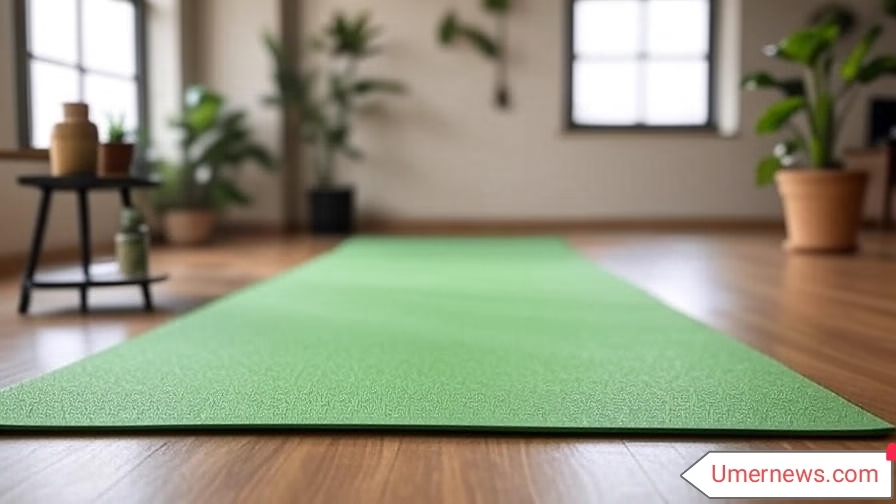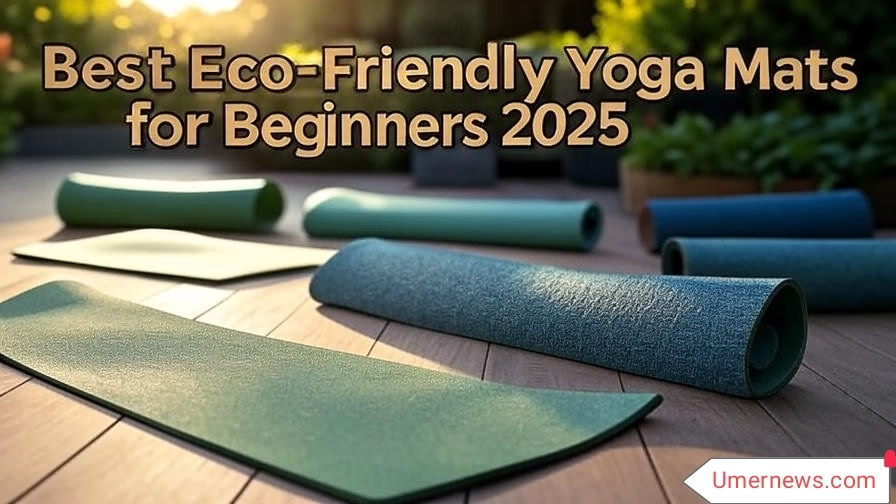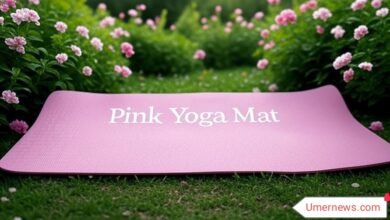Best Eco-Friendly Yoga Mats for Beginners 2025
Contents
Best Eco-Friendly Yoga Mats for Beginners 2025

Yoga is a transformative practice that promotes physical and mental well-being, and choosing the right yoga mat is essential for beginners embarking on this journey. For those prioritizing sustainability, eco-friendly yoga mats made from natural, non-toxic, and sustainable materials offer a perfect blend of performance and environmental responsibility. In 2025, the demand for eco-conscious yoga gear continues to rise, driven by practitioners who value both their practice and the planet.
Why Choose Eco-Friendly Yoga Mats?
Eco-friendly yoga mats are crafted from sustainable materials like natural rubber, cork, organic cotton, or jute, avoiding harmful chemicals like PVC, phthalates, or synthetic additives. These mats are often biodegradable, recyclable, or produced using ethical and environmentally conscious methods, aligning with the values of mindful yogis. For beginners, these mats provide a safe, non-toxic surface to practice on, ensuring comfort and stability while minimizing environmental impact.
Benefits of Eco-Friendly Yoga Mats
- Sustainability: Made from renewable or recycled materials, reducing environmental harm.
- Non-Toxic: Free from harmful chemicals like phthalates, PVC, or heavy metals, ensuring safer practice.
- Durability: High-quality natural materials often last longer, offering value for money.
- Grip and Comfort: Designed to provide excellent traction and cushioning, ideal for beginners learning poses.
- Ethical Production: Many brands prioritize fair labor practices and eco-conscious manufacturing.
Top Eco-Friendly Yoga Mats for Beginners in 2025
Based on extensive research, testing insights from authoritative sources, and beginner-friendly features, here are the top eco-friendly yoga mats for 2025. Each mat was selected for its balance of sustainability, grip, cushioning, and affordability, ensuring beginners can practice confidently while supporting eco-conscious brands.
| Yoga Mat | Material | Thickness | Weight | Price | Best For | Key Features |
|---|---|---|---|---|---|---|
| Manduka eKO Lite | Natural Rubber | 4mm | 4 lbs | $94 | All-around practice | Excellent grip, biodegradable, sustainable rubber |
| JadeYoga Harmony | Natural Rubber | 4.75mm | 5 lbs | $85 | Hot yoga, Vinyasa | Superior traction, eco-friendly, tree-planting initiative |
| Scoria Botanical Cork Mat | Cork, Natural Rubber | 4.5mm | 2.5 lbs | $99 | Restorative, hot yoga | Antimicrobial, non-slip, lightweight |
| Brentwood Home Cotton Yoga Mat | Organic Cotton, Latex | 4mm | 3 lbs | $179 | Gentle yoga | GOTS-certified cotton, breathable, non-slip latex |
| Iuga Eco Friendly Non Slip | TPE | 6mm | 2.1 lbs | $40 | Budget-conscious beginners | Affordable, recyclable, good cushioning |
1. Manduka eKO Lite
- Why It’s Great: The Manduka eKO Lite is made from sustainably harvested natural rubber, offering excellent grip even when wet, making it ideal for dynamic practices like Vinyasa or hot yoga. Its 4mm thickness provides a balance of cushioning and stability, perfect for beginners mastering poses like Downward Dog or Warrior II.
- Sustainability: Biodegradable, free of PVC and harmful plasticizers, and manufactured with low-carbon processes.
- Best For: Beginners seeking a durable, grippy mat for various yoga styles.
- Note: Slightly heavier than some options, so consider portability needs.
2. JadeYoga Harmony
- Why It’s Great: The JadeYoga Harmony is a favorite for its superior traction and eco-conscious design. Made from natural rubber, it’s free of PVC, EVA, or synthetic materials, and Jade plants a tree for every mat sold. Its 4.75mm thickness offers ample cushioning for joints, ideal for beginners.
- Sustainability: Natural rubber is renewable, and the brand’s recycling program allows old mats to be repurposed.
- Best For: Hot yoga or sweaty practices due to its sweat-absorbing grip.
- Note: Has a mild rubber odor initially, which fades over time.
3. Scoria Botanical Cork Mat
- Why It’s Great: The Scoria Botanical Cork Mat combines cork and natural rubber for a lightweight, antimicrobial surface that’s perfect for hot yoga or restorative sessions. Its 4.5mm thickness provides comfort without compromising stability, and its beautiful designs inspire beginners.
- Sustainability: Cork is naturally antimicrobial and harvested without harming trees, while the rubber backing is eco-friendly.
- Best For: Beginners prioritizing aesthetics and eco-friendliness.
- Note: Avoid folding to prevent cork cracking; roll with cork facing out.
4. Brentwood Home Cotton Yoga Mat
- Why It’s Great: The Brentwood Home Cotton Yoga Mat uses GOTS-certified organic cotton and natural Dunlop latex, offering a soft, breathable surface with excellent grip. Its 4mm thickness is ideal for gentle yoga, making it a great choice for beginners.
- Sustainability: Free of chemical retardants, phthalates, and heavy metals, with ethical production in Los Angeles.
- Best For: Beginners with sensitive skin or those practicing restorative yoga.
- Note: Higher price point, but worth it for premium quality.
5. Iuga Eco Friendly Non Slip
- Why It’s Great: The Iuga Eco Friendly Non Slip is a budget-friendly option made from recyclable TPE, offering 6mm of cushioning for extra joint support. Its lightweight design (2.1 lbs) makes it easy to carry to classes, ideal for beginners on the go.
- Sustainability: TPE is recyclable and less harmful than PVC, though not as natural as rubber or cork.
- Best For: Budget-conscious beginners needing portability and cushioning.
- Note: Less durable than natural rubber mats, so frequent replacement may be needed.
How to Choose an Eco-Friendly Yoga Mat as a Beginner

Selecting the right yoga mat can enhance your practice and align with your values. Here are key factors to consider:
- Material: Opt for natural rubber, cork, or organic cotton to avoid toxic chemicals like PVC or phthalates. Check for third-party certifications (e.g., GOTS, FSC) to verify eco-claims.
- Thickness: Beginners benefit from 4-6mm mats for a balance of cushioning and stability. Thicker mats (6mm+) are great for joint support, while thinner mats (3-4mm) offer better grounding.
- Grip: Look for mats with excellent traction, especially for sweaty practices. Cork and natural rubber excel in wet conditions.
- Portability: Lightweight mats (under 3 lbs) are ideal for commuting to yoga classes.
- Price: Eco-friendly mats range from $40-$179. Budget options like Iuga are great for beginners, while premium mats like Manduka offer long-term value.
- Sustainability: Choose brands with transparent eco-practices, such as biodegradable materials, recycling programs, or carbon-neutral production.
Caring for Your Eco-Friendly Yoga Mat
To extend the lifespan of your mat and maintain its eco-friendly benefits:
- Clean Regularly: Wipe with a damp cloth or use a natural mat spray (e.g., JadeYoga’s spray). Avoid harsh chemicals.
- Store Properly: Roll (don’t fold) to prevent damage, especially for cork mats. Store in a cool, dry place.
- Recycle: Check if the brand offers a recycling program, like JadeYoga or Manduka, to responsibly dispose of old mats.
FAQs
What makes a yoga mat eco-friendly?
An eco-friendly yoga mat is made from sustainable, non-toxic materials like natural rubber, cork, or organic cotton, and is often biodegradable or recyclable. It avoids harmful chemicals like PVC or phthalates and is produced using ethical, low-impact methods.
Are eco-friendly yoga mats suitable for beginners?
Yes, eco-friendly yoga mats are ideal for beginners due to their non-toxic materials, good grip, and cushioning, which provide a safe and comfortable surface for learning poses. Mats like the Manduka eKO Lite or Iuga Eco Friendly Non Slip are great choices.
How do I clean an eco-friendly yoga mat?
Wipe the mat with a damp cloth or a natural mat cleaner after each use. For deeper cleaning, use a mild soap and water solution, then air dry. Avoid harsh chemicals to preserve the mat’s eco-friendly properties.
Which eco-friendly yoga mat is best for hot yoga?
The JadeYoga Harmony and Scoria Botanical Cork Mat are excellent for hot yoga due to their superior grip when wet and antimicrobial properties.
Are eco-friendly yoga mats worth the investment?
Yes, eco-friendly yoga mats are durable, non-toxic, and environmentally responsible, offering long-term value. While some are pricier, budget options like Iuga provide affordability without sacrificing sustainability.
Conclusion
Choosing an eco-friendly yoga mat in 2025 is a meaningful step for beginners who want to align their practice with sustainability. Mats like the Manduka eKO Lite, JadeYoga Harmony, and Scoria Botanical Cork Mat offer the perfect blend of grip, comfort, and eco-conscious design, ensuring a safe and enjoyable yoga journey. By prioritizing natural materials, ethical production, and durability, these mats support both your practice and the planet. Start your yoga journey with confidence, knowing you’re making a positive impact.








